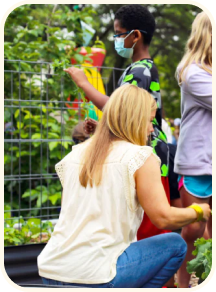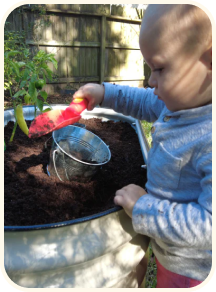Creating Compost: Why You Need Brown and Green
If you’ve heard of compost, but you aren’t quite sure what goes in it, rest assured: The ingredients fall into two basic categories.
First, you’ll need a healthy portion of moist stuff (think coffee grounds, fresh manure, food scraps, tea bags and fresh grass cuttings). Gardeners refer to these fresh ingredients as “green.” They contribute nitrogen to the mix.

From there, you’ll need an even larger portion of crunchy stuff (dried leaves, newspaper, cardboard, hay, straw, acorns, and dry twigs and branches). The dry items are considered “brown,” and they provide carbon.

Broken down and blended, these recycled ingredients become a highly effective, natural fertilizer for your garden soil and raised beds.
“Compost is used to improve your soil’s physical, chemical and biological properties,” Vego Garden Horticulturist Sydney Fiene said. “It really makes your soil absolutely incredible for your vegetables, for all of your growing needs.”
Everything in Proportion
As far as your compost ingredients’ measurements, Fiene recommends aiming for a ratio of about 30 parts brown to one part green.
Don’t worry about getting the mix perfect, Fiene said. Just remember you’ll need significantly more brown ingredients than green materials.
“If you add too many food scraps, and not enough sticks, not enough cardboard, it can become very nitrogen rich,” she said. “A lot of your vegetables and herbs don't want a soil super high in nitrogen. Plus, nitrogen can cause your compost to heat up very quickly.”
Not only can excessive heat promote mold and fungus growth, but in rare circumstances it can even cause compost piles to spontaneously combust.
On the other hand, excessive brown materials can slow your pile’s transformation from home and garden scraps to compost.
“A very simple solution to this would be to add some nitrogen fertilizer to the pile and turn over your compost,” Fiene said.
Blend, Soak, and Cover
Fiene suggests starting compost piles with a base of large materials—logs, branches and sticks— to promote airflow. From there, add layers of about two to four inches of green materials and about six inches of brown materials. But again, don’t worry about exact measurements.
Aside from the large branches on the bottom of your pile, try to keep the items you add to your pile small to speed up decomposition. You can cut up branches, for example, with scissors or pruning shears.
Every time you toss more green and brown items into your pile, mix your compost and soak the pile with water.
Beyond that, nature will do most of the work. One possible exception is climate control. During the winter months, Fiene recommends covering the compost pile with a tarp. But during warm weather, it’s best to leave the compost pile uncovered to prevent overheating.
As you can see, building your compost pile is not especially complicated.
“It’s really hard to mess up composting,” Fiene said. “I think the biggest mistake would be too much heat and not enough airflow, not turning the compost over or giving it the moisture it needs. But those things are easy to fix. It’s a forgiving process.”
Ready to Serve
Once your compost starts to smell earthy, rather than like rotting vegetables, and it looks rich in color, it is ready to go.
Then, you can give your soil a healthy serving.
Fiene recommends about 1/4 to 1/2 inch of compost when you’re applying it on top of the soil. Another way to use the compost is to amend it with your soil. A rough ratio for amending is one to two inches of compost mixed with six to eight inches of soil.
For the final touch, add finishing soil to create a beautiful blend for your garden beds.





























Leave a comment